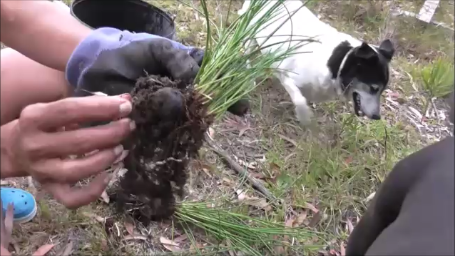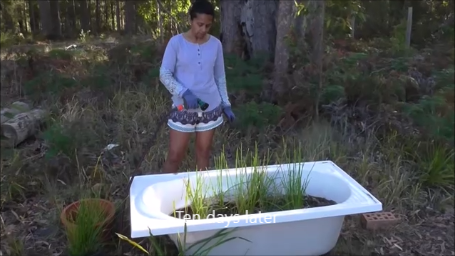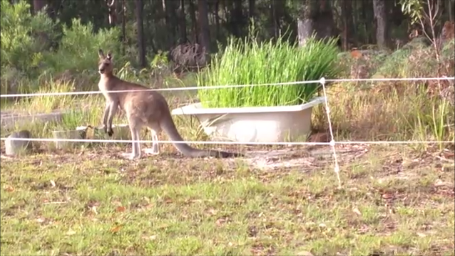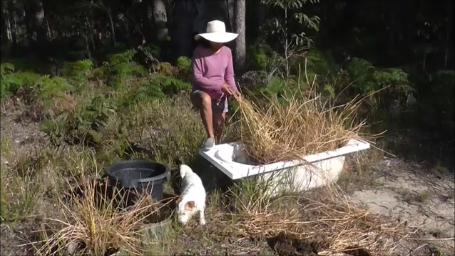I have mainly eaten water chestnuts in Chinese stir-fry. Most people in Australia don’t even know what water chestnuts are, although they would have eaten it at a Chinese restaurant. Next time you order a mixed vegetable dish at a Chinese restaurant, look for water chestnuts amongst the chunky cauliflower and floral-cut carrots and layers of snow peas. They are round, white and crunchy, easily mistaken for a nut. A water chestnut is actually an acquatic vegetable, a type of marshy grass which has an edible root. I prefer homegrown water chestnuts as they are tastier than the canned ones. The health benefits of water chestnuts include anti-oxidants similar to those found in chocolate, green tea and red wine.

Corms are ready to be transplanted to the bathtub once they have green shoots like this that look like grass. That’s my dog Lina in the photo. This was the last harvest time I shared with her as she went to be with Jesus shortly after. I miss you baby girl!

After ten days
T
Today the more adventurous foodies are using water chestnuts in Western dishes too. For example, dressing up the mundane pumpkin soup with water chestnuts gives a nice bite to it. If you’re making a vegetable wrap, throw water chestnuts into the filling. A famous Thai dessert, Tab Tim Grob uses water chestnuts as its main feature.

kangaroo relaxing in front of my bathtub where I was growing water chestnuts. By now the tub is filled to the brim with water chestnuts
The water chestnuts eaten at restaurants are usually out of a can. While the canned version is still crunchy, it is missing the sweet, nutty and tart flavour only found in fresh or homegrown water chestnuts. I used an old bathtub to grow mine. I started with just six corms I purchased online from a nursery selling organic and heirloom plants.

When I went to top up the water in the bathtub the kangaroo left. I was sorry to see him leave
It took about ten months from planting to harvest. Once you wash the mud off the chestnuts you can see their purplish-brown colour. Water chestnuts don’t last long once harvested.
A large crop of homegrown water chestnuts will have to be stored properly for long-term use. Some of the homegrown water chestnuts I harvested were peeled and then frozen in zip lock bags. But I prefer the second method I used with the rest of the chestnuts, which is fermenting them whole, complete with skin, in salt water. I just use them as and when I need them. They are tastier than the frozen chestnuts.

When the leaves turn brown they are ready to harvest
A large crop of homegrown water chestnuts will have to be stored properly for long-term use. Some of the homegrown water chestnuts I harvested were peeled and then frozen in zip lock bags. But I prefer the second method I used with the rest of the chestnuts, which is fermenting them whole, complete with skin, in salt water. I just use them as and when I need them. They are tastier than the frozen chestnuts.

The chestnuts are formed at the end of the roots. So I had to break up the soil and dig through the roots to pick out the chestnuts.
The highlight of last year’s crop must surely be stumbling upon a kangaroo relaxing in front of my bathtub, now covered from end to end with the long, grassy tops of the water chestnuts. The kangaroo didn’t disturb the plant. He was just lying down in front of the bathtub. He wasn’t perturbed by me walking up to him either until I got a bit too close. Watch the video below to see him.



0 Comments